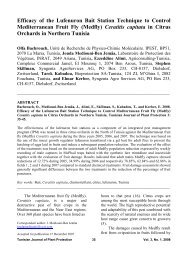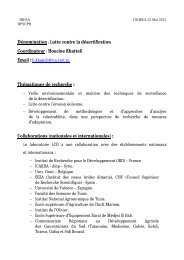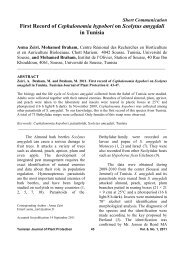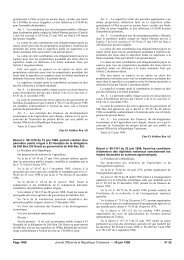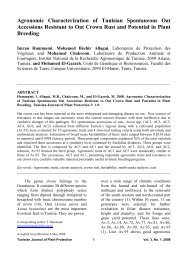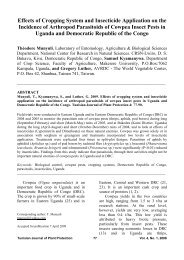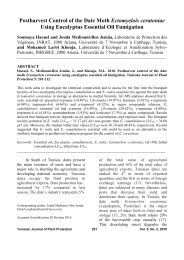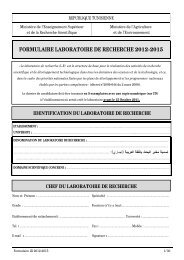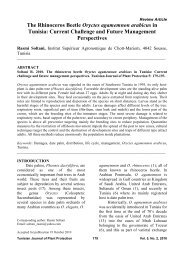The Gall Wasp Plagiotrochus amenti Potentially Dangerous ... - Iresa
The Gall Wasp Plagiotrochus amenti Potentially Dangerous ... - Iresa
The Gall Wasp Plagiotrochus amenti Potentially Dangerous ... - Iresa
Create successful ePaper yourself
Turn your PDF publications into a flip-book with our unique Google optimized e-Paper software.
Short Communication<br />
<strong>The</strong> <strong>Gall</strong> <strong>Wasp</strong> <strong>Plagiotrochus</strong> <strong>amenti</strong> <strong>Potentially</strong> <strong>Dangerous</strong><br />
for the Cork Oak Found for the First Time in Tunisia<br />
Juli Pujade-Villar, Universitat de Barcelona, Facultat de Biologia, Departament de<br />
Biologia Animal, Avda, Diagonal, 645 E-08028-Barcelona, Spain, Mabrouk<br />
Grami, and Mohamed-Lahbib Ben Jamâa, INRGREF, BP 10, Ariana 2080,<br />
Université de 7 Novembre à Carthage, Tunisia<br />
__________________________________________________________________________<br />
ABSTRACT<br />
Pujade-Villar, J., Grami, M., and Ben Jamâa, M.L. 2010. <strong>The</strong> gall wasp <strong>Plagiotrochus</strong> <strong>amenti</strong><br />
potentially dangerous for cork oak found for the first time in Tunisia. Tunisian Journal of Plant<br />
Protection 5: 225-230.<br />
<strong>The</strong> occurrence of <strong>Plagiotrochus</strong> <strong>amenti</strong> in Tunisia is reported here for the first time. This gallicolous<br />
wasp is a potential pest for the oak tree, and its expansion could result in economical losses in Tunisia<br />
for the cork industry. <strong>The</strong> dangers of its potential proliferation are exposed. <strong>The</strong> indications for<br />
recognition of its appearance are given.<br />
Keywords: Cynipidae, Hymenoptera, Pest, <strong>Plagiotrochus</strong> <strong>amenti</strong>, Quercus suber, Tunisia<br />
__________________________________________________________________________<br />
<strong>The</strong> cork oak (Quercus suber) is<br />
used in the Western Mediterranean area<br />
as a resource for cork plantation. This<br />
species is distributed in 7 countries:<br />
Portugal, Spain, France and Italy (in<br />
Europe) and Tunisia, Morocco and<br />
Algeria (in North Africa), with an area of<br />
2.3 million ha (63% in Europe and 37%<br />
in Africa). This important resource has<br />
many natural enemies (17). In Tunisia,<br />
some of them, especially the larvae of<br />
Lepidoptera such as Lymantria dispar are<br />
able to attack leaves and to cause severe<br />
defoliation. Other insects, as the larvae of<br />
beetles Platypus cylindrus, Cerambyx<br />
cerdo, and the ant Crematogaster<br />
Corresponding author: Mohamed-Lahbib Ben Jamâa<br />
Email: benjamaa.lahbib@iresa.agrinet.tn<br />
Accepted for publication 23 November 2010<br />
scutellaris, produce various wood injuries<br />
which can be invaded by fungi and other<br />
micro-organisms that can cause serious<br />
disruptions in the cork oak. By infesting<br />
the tree, these insects affect the quality or<br />
prevent the extraction of the cork while<br />
others cause the death of branches or the<br />
cork oak itself. Recently (2), a potential<br />
new pest has been found in Algeria:<br />
<strong>Plagiotrochus</strong> <strong>amenti</strong> (Hymenoptera:<br />
Cynipidae). In the present paper, we<br />
record the presence of this species for the<br />
first time in Tunisia. A recently approved<br />
project related to the Tunisian-Spanish<br />
bilateral cooperation granted by AECID<br />
(2009) has permitted the authors to<br />
sample the oaks in the North of Tunisia.<br />
<strong>The</strong> material has been collected and<br />
deposited in the collections of the<br />
University de Barcelona (UB) and Institut<br />
National des Recherches en Génie Rural<br />
Eaux et Forêts (INRGREF) (Fig. 1).<br />
Tunisian Journal of Plant Protection 225 Vol. 5, No. 2, 2010
Fig. 1. Damages noted on Q. suber; a: Death of Q. suber branches<br />
caused by Diplodia sp. and resembling attacks of P. <strong>amenti</strong>, b:<br />
Branch of Q. suber attacked by the asexual generation of P.<br />
<strong>amenti</strong>, c: Asexual form of P. <strong>amenti</strong>, d: Twig with galls of the<br />
sexual form of P. <strong>amenti</strong>.<br />
This study was conducted in the<br />
cork oak forest located in the Northwest<br />
of Tunisia. <strong>The</strong> relief is often bumped<br />
where the altitude varies from 400 to<br />
1203 m (Jebel Ghorra). Rains are<br />
abounding and vary from 800 to 1500<br />
mm (Aïn Draham). <strong>The</strong> annual medium<br />
temperature drops with altitude 18°C in<br />
Tabarka and 15°C in Aïn Draham. <strong>The</strong><br />
absolute maximum temperature of August<br />
is about of 47°C in Tabarka, 43°C in Aïn<br />
Draham and 49°C in El Feija. <strong>The</strong><br />
Khemir-Mogods Mountain belongs to the<br />
humid Mediterranean climatic and it is<br />
characterized by a very strong summer<br />
dryness contrasting with a very important<br />
winter rainfall measurement. <strong>The</strong> gall<br />
wasps were collected on Q. suber trees<br />
from different cork oak forests (Fig. 2)<br />
between February and March 2009 for all<br />
localities and from Ain Ezzana in October<br />
2009.<br />
Tunisian Journal of Plant Protection 226 Vol. 5, No. 2, 2010
Locality number Locality Altitude (m)<br />
1 Ain Ezzana 924<br />
2 Khroufa 361<br />
3 Bellif 91<br />
4 Tababa 249<br />
5 El Jouza 543<br />
6 Ain Snoussi 603<br />
7 Majen Essaf 548<br />
8 Sleimia 97<br />
9 Bouterfes 46<br />
10 El Feija 763<br />
11 El Gonna 438<br />
12 Adissa 453<br />
13 Ain El Beya 247<br />
Fig. 2. Localities in which gall wasps of P. <strong>amenti</strong> were collected on Q. suber trees.<br />
<strong>The</strong> species, P. <strong>amenti</strong> has been<br />
detected from Tunisia. We have collected<br />
asexual and sexual galls, and asexual<br />
adults in different points of the Khemir<br />
Mountains (Table 1).<br />
Table 1. Studied material: asexual and sexual galls, and sexual adults collected in different points of the<br />
Khemir mountains<br />
Locality Date of collect Date of Generation Number of adults<br />
emergence<br />
Nefza (Beja) 24.02.2009 02.03.2009 sexual 3 females<br />
05.03.2009 1 female<br />
10.03.2009 3 females<br />
Tabarka (Jendouba) 24.02.2009 02.03.2009 sexual 4 females<br />
Ain Ezzana (Ain Draham) 27.10.2009 asexual<br />
asexual<br />
Tunisian Journal of Plant Protection 227 Vol. 5, No. 2, 2010
P. <strong>amenti</strong> is native from the Western<br />
Mediterranean area, where the host (Q.<br />
suber) is present. It has been reported<br />
from Portugal and Spain (8, 10), France<br />
(12) and recently from Algeria (2); it was<br />
also recorded in Switzerland (1) but Q.<br />
suber is not indigenous for this country. It<br />
has also been mentioned from Andorra<br />
100 Km far away from its host plant due<br />
probably to the wind effect (14). P.<br />
<strong>amenti</strong> was also introduced to North<br />
America (18) and Argentina (4). <strong>The</strong> oak<br />
cynipids, grouped in the tribe Cynipini,<br />
have an alternating cycle (11). This cycle<br />
is characterized by a sexual generation<br />
(with the presence of males and females)<br />
followed by another asexual (only<br />
females). Both generations were recorded<br />
in the present work and they are known to<br />
produce different galls, almost always in<br />
different plant organs.<br />
Kieffer (6), based in a collection<br />
made in Portugal, described a gall in the<br />
catkins of the cork oak caused by an<br />
insect species named P. <strong>amenti</strong>. Later on,<br />
Tavares (15) re-described this gall type<br />
and the sexual adults producing it.<br />
Nieves-Aldrey (7) detected in Spain the<br />
sexual form in one-year branches of Q.<br />
suber and also described a new asexual<br />
form, P. pardoi from branches, which<br />
belongs (synonym) (9) to P. suberi<br />
described by Weld (18) from USA in<br />
introduced Q. suber. P. suberi was also<br />
mentioned in Argentinean plantations (4).<br />
<strong>The</strong> cycle between P. <strong>amenti</strong> and P.<br />
suberi has been recently closed (5, 13).<br />
<strong>The</strong> adult of the asexual form (Fig. 1c)<br />
and the females of the sexual form have a<br />
very similar morphology (7). <strong>The</strong> galls of<br />
the sexual form are commonly found in<br />
annual branches (Fig. 1d), while the<br />
asexual form is located in branches from<br />
2 to 3 years (Fig. 1b).<br />
<strong>The</strong> galls of the asexual form and<br />
those of the sexual form found in the<br />
twigs can cause damage to the branches<br />
of Q. suber. When the number of larval<br />
chambers is small, they weaken or reduce<br />
the strength of the tree and may cause the<br />
death of the branch, resembling an attack<br />
occasioned by Diplodia sp. (Fig. 1a).<br />
Large economic losses caused by the<br />
asexual form gall wasp have been<br />
reported in Argentina and the USA<br />
(EEUU) (2, 4, 19). At the end of the 20 th<br />
century, punctual demographic<br />
explosions of this gall wasp were<br />
observed in the North-Eastern Iberian<br />
Peninsula (Pujade-Villar, unpublished<br />
data) generating local disruptions similar<br />
to those described in the American<br />
continent, which is evidenced by a<br />
yellowing of the leaves, before the death<br />
of the affected limbs. For all the reasons<br />
mentioned above, the detection of this<br />
gall wasp is important as it represents a<br />
threat for the Tunisian cork oak forest: a<br />
future expansion of this hymenopteran<br />
may cause additional difficulties in the<br />
Tunisian cork economy. P. <strong>amenti</strong> is a<br />
very serious potential plague of Q. suber.<br />
ACKNOWLEDGEMENTS<br />
This research has been supported by the<br />
Tunisian-Spanish bilateral cooperation Project n°<br />
A/017545/08 of the AECID (Agencia Española de<br />
Cooperación Internacional para el Desarrollo).<br />
Authors thank Jordi Paretas-Martínez for his<br />
criticism.<br />
__________________________________________________________________________<br />
RESUME<br />
Pujade-Villar J., Grami M. et Ben Jamâa M.L. 2010. La guêpe gallicole <strong>Plagiotrochus</strong> <strong>amenti</strong><br />
potentiellement dangereuse pour le chêne-liège trouvée pour la première fois en Tunisie.<br />
Tunisian Journal of Plant Protection 5: 225-230.<br />
Tunisian Journal of Plant Protection 228 Vol. 5, No. 2, 2010
La présence de <strong>Plagiotrochus</strong> <strong>amenti</strong> en Tunisie est mentionnée pour la première fois ici. Cette guêpe<br />
gallicole est un insecte potentiellement nuisible pour le chêne et son expansion pourrait engendrer des<br />
pertes économiques pour l’industrie du liège en Tunisie. La biologie de cette espèce et les dangers de sa<br />
prolifération potentielle sont exposés. Les indications de reconnaissance de cet insecte sont également<br />
données.<br />
Mots clés: Cynipidae, Hymenoptera, insecte nuisible, <strong>Plagiotrochus</strong> <strong>amenti</strong>, Quercus suber, Tunisie<br />
__________________________________________________________________________<br />
ملخص<br />
بوجاد-فييار جولي ومبروك قرامي ومحمد الحبيب بن جامع.<br />
ذي الخطورة المحتملة على فلين<br />
2010. العثور لأول مرة على دبور التدرن<br />
الفرنان/السنديان.<br />
Tunisian Journal of Plant Protection 5: 225-230<br />
<strong>Plagiotrochus</strong> <strong>amenti</strong><br />
على الفرنان في تونس لأول مرة. يمكن أن يكون هذا الدبور<br />
تمت الإشارة هنا إلى وجود حشرة<br />
المُحدث للتدرن آفة محتملة لأشجار الفرنان ويمكن أن يُلحق انتشاره خسائر اقتصادية جسيمة لقطاع الفلين بتونس. تم<br />
التعرض إلى مخاطر انتشار هذه الحشرة وتكاثرها المحتمل، آما تم إعطاء دلالات لتشخيص الحشرة.<br />
<strong>Plagiotrochus</strong> <strong>amenti</strong><br />
آلمات مفتاحية: تونس، حشرة ضارة، عفصيات ،غشائيات الأجنحة، ،Quercus suber<br />
<strong>Plagiotrochus</strong> <strong>amenti</strong><br />
__________________________________________________________________________<br />
LITERATURE CITED<br />
and J. Templado, éds. Museo Nacional de<br />
1. Bailey, S.F. and Stange, L.A. 1966. <strong>The</strong> twing<br />
Ciencias Naturales. Vol. 16, Madrid, 636 pp.<br />
wasp of cork oak-its biology and control. J. 9. Pujade-Villar, J. 1998. A propósito de la posición<br />
Econ. Entomol. 59: 663-668.<br />
taxonómica de las especies del género<br />
2. Benia, F., Khelil, M.A., and Pujade-Villar, J.<br />
<strong>Plagiotrochus</strong> Mayr en el continente americano<br />
2009. Présence en Algérie de <strong>Plagiotrochus</strong><br />
(Hymenoptera: Cynipidae) Butlletí de la<br />
<strong>amenti</strong> (Hymenoptera, Cynipidae): une espèce<br />
Institució Catalana d’Història Natural 66: 112-<br />
gallicole potentiellement dangereuse pour le<br />
113.<br />
chêne-liège (Quercus suber L.). Nouv. Rev. 10. Pujade-Villar, J. 2002. Una presentación<br />
Entomol. 25: 291-296.<br />
excelente para un volumen con demasiados<br />
3. Boudy, P. 1952. Guide du forestier en Afrique du<br />
errores: Nieves-Aldrey (2001) Hymenoptera,<br />
Nord. La Maison Rustique, Paris, France, 505<br />
Cynipidae. Bol. Asoc. Esp. Entomol. 26: 143-<br />
pp.<br />
159.<br />
4. Díaz, N.B. 1973. Una nueva plaga del alcornoque 11. Pujade-Villar, J., Bellido, D., Segú, D., and<br />
en la República Argentina. Rev. Soc. Entomol.<br />
Melika, G. 2001. Current state of knowledge of<br />
Argent. 34: 85-88.<br />
heterogony in Cynipidae (Hymenoptera,<br />
5. Garbin, L., Díaz, N.B., and Pujade-Villar, J. 2008.<br />
Cynipoidea). Sesió Conjunta d’Entomologia de<br />
Experimental study of the reproductive cycle of<br />
la Institució Catalana d’Història Natural-<br />
<strong>Plagiotrochus</strong> <strong>amenti</strong> Kieffer, 1901<br />
Societat Catalana de Lepidopterologia 11: 87-<br />
(Hymenoptera, Cynipoidea, Cynipidae), with<br />
107.<br />
comments on its taxonomy. Bol. Asoc. Esp. 12. Pujade-Villar, J., Villemant, C., and Andrei-<br />
Entomol. 32: 241-249.<br />
Ruiz, M.C. 2000. Cynipidae associated with<br />
6. Kieffer, J.J. 1901. Synopsis des Zoocecidies<br />
Quercus collected in Corsica with the<br />
d'Europe. Ann. Soc. Entomol. Fr. 70: 233-579.<br />
description of a new <strong>Plagiotrochus</strong> species<br />
7. Nieves-Aldrey, J.L. 1985. Biologia de<br />
(Hymenoptera, Cynipoidea). Zoosystema 22:<br />
<strong>Plagiotrochus</strong> <strong>amenti</strong> Tav. (Hym., Cynipidae),<br />
835-846.<br />
Cinípido cecidógeno nocivo para el alcornoque. 13. Pujade-Villar, J., Garbin, L., Paretas-Martínez,<br />
II Congresso Ibérico de Entomologia. Bol. Soc.<br />
J., and Díaz, N.B. 2008. On the biological cycle<br />
Portug. Entomol. (Supplement) 1: 105-115.<br />
of the gall wasp <strong>Plagiotrochus</strong> suberi Weld<br />
8. Nieves-Aldrey, J.L. 2001. Hymenoptera,<br />
1926 (Hymenoptera: Cynipoidea: Cynipidae) in<br />
Cynipidae. Page 636. In: Fauna Ibérica. M.A.<br />
the circum-Mediterranean region. Contributions<br />
Ramos, J. Alba, X. Bellés, J. Gosálbez, A.<br />
to Zoology 77: 249.<br />
Guerra, E. Macpherson, F. Martín, J. Serrano, 14. Ros-Farré, P. and Pujade-Villar, J. 1998. Estudio<br />
mediante una trampa malaise de la comunidad<br />
Tunisian Journal of Plant Protection 229 Vol. 5, No. 2, 2010
de Cinipidos cecidogenos e Inquilinos de Santa<br />
Coloma, Andorra (Hymenoptera, Cynipidae).<br />
Ecologia 12: 441-454.<br />
15. Selmi, K. 2006. Utilisation des données et<br />
résultats de l’inventaire forestier national pour<br />
la gestion des forêts de chêne-liège en Tunisie.<br />
Ann. INRGREF 9: 21-30.<br />
16. Tavares, J. 1902. Espécies novas de cynípides e<br />
cecydomias da península ibérica e descripçao de<br />
algumas já conhecidas. Broteria. Série<br />
Zoologica 20: 97-155.<br />
17. Villemant, C. 2007. Oak forest pests: life cycles,<br />
damages and control. Available online:<br />
www.efn.com.pt/Session3/Villemant.pdf.<br />
18. Weld, L.H. 1926. Field notes on gall-inhabiting<br />
cynipid wasps with descriptions of new species.<br />
Proceedings of the United States National<br />
Museum 68: 1-8.<br />
19. Zuparko, R.L. 1996. Hymenoptera reared from<br />
<strong>Plagiotrochus</strong> suberi (Hymenoptera:<br />
Cynipidae) galls in California. Pan-Pacific<br />
Entomologist 72: 27-30.<br />
------------------------<br />
Tunisian Journal of Plant Protection 230 Vol. 5, No. 2, 2010






